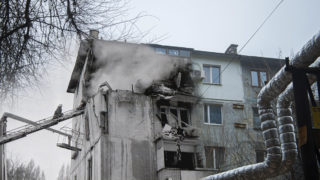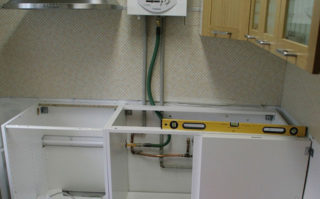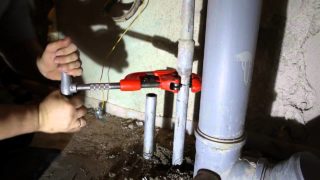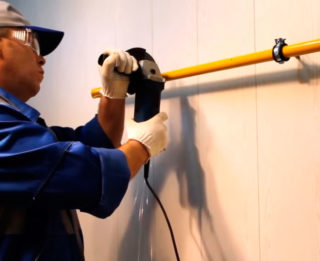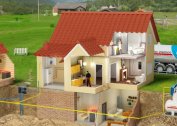Gas pipes are a source of increased danger. The slightest violation of technology when trimming them is fraught with a health risk and even explosion with fatal consequences. To change the configuration of the gas pipeline in the apartment correctly and without complications, you should familiarize yourself with the standards established by law in this field of activity, the rules and the sequence of work.
Requirements for the contractor and customer
The gas pipeline, including fragments of it in the apartment, is the property of the management company. Based on this, only the actual owner has the right to make any changes, cut off fragments, shorten and lengthen the pipes. The powers of the owners or tenants of real estate are limited only by writing an application and conducting minor preparatory work without interfering with the system.
To be entitled to shorten the pipe, the customer must meet the following requirements:
- have a certificate of ownership of the apartment;
- to be a tenant, subject to the availability of a contract that spells out the possibility of making changes to communications;
- not have debts for utilities.
All this must be documented.
The contractor has more stringent requirements:
- license for gas manipulation;
- specialized education, confirmed by a certificate, diploma or certificate;
- documenting the intervention in the system and the changes made;
- the use of instrumentation;
- the availability of production instructions for gas hazardous work;
- employment record and official employment.
This list is due to the high responsibility of the master for the performance of explosive work. Therefore, it is prohibited by law to shorten gas pipes in the kitchen with the involvement of random persons by announcement. It is necessary to apply to professionals vested with legal rights.
The need for trimming a gas pipe
Reasons to shorten pipes:
- Carrying out repairs if it is planned to move the stove to a new location.
- Setting the counter when you need to make the tap shorter.
- The transfer of the meter to the visibility zone at the request of the management company.
- Bringing the wiring in accordance with the changed standards.
- Irrational pipe arrangement, which interferes with the optimal arrangement of the kitchen set and household appliances.
In all cases, the customer does not have the right to interfere in the operation of the gas system, independently disconnect and violate its integrity.
Preparatory stage
Trimming is not carried out in one day, it is a process that requires some preparation.
Preliminary activities consist of the following stages:
- Familiarization with SNiP 2.04.08-87. This act spells out the rules for the construction of in-house gas pipelines. Knowledge of the theory will allow you to create one or more options that meet the requirements of the law.
- Drafting and filing an application. It is written in any form, indicating its passport data, address and nature of the application. A scheme of proposed changes is attached to the paper.
- Reception master.The specialist inspects the premises, makes measurements, agrees with the proposals or makes adjustments to them. Other options may be suggested.
- The liberation of the kitchen from objects that may interfere with work and suffer during the process. Covering furniture with mounting film.
In conclusion, the tap is shut off with further burning of gas in the pipe and stove.
Pipe trimming equipment
The following equipment can be used to cut the gas pipe:
- Hacksaw for metal. This is a lightweight hand tool for accurate and accurate cuts. In addition, there is no dust, smoke or drops of molten metal. The downside is that you have to spend time and effort.
- Pipe cutter. The product allows you to cut at the exact angle without any waste and debris. The nuance is that the pipe cutter has impressive dimensions, which may not allow it to be inserted between the communication and the wall.
- Bulgarian. A high-speed machine capable of cutting off a piece of metal in a matter of seconds. Minus in a huge amount of dust and sparks that can ruin the interior elements.
- Welding. When used correctly, the machine makes quick and accurate cuts. The disadvantage is fire hazard and the formation of sagging on the metal, requiring additional processing.
An experienced master is able at the initial inspection to make the best choice in favor of using this or that equipment.
Gas pipe cutting methods
There are different ways to cut pipes. Sawing with a hacksaw or pipe cutter is used when a stretch ceiling is installed in the kitchen, which is sensitive to heat and sparks.
When there is no risk of spoiling the whitewash in the room, a grinder is used. Here you need to take into account the degree of gas contamination of the room. Sawing is possible only after complete weathering of propane.
Welding is used when assembling a new pipeline for connecting fittings, elbows and nozzles. Sometimes, by welding, a ball valve crashes into the system.
Rules for trimming and moving the pipe
The following rules apply to trimming and transferring gas pipes:
- maintaining access to metering, control and shutoff valves;
- finding valves in an open area;
- the use of flexible elements exclusively for connecting consumers;
- production of plugs of fixed type by brewing holes.
For joining, metals of the same class with an equal coefficient of thermal expansion are used. This will prevent cracking due to temperature differences in the kitchen.
Installation steps
The transfer of pipes is carried out in the following sequence:
- Warning tenants porch.
- Disconnect gas to the riser.
- Organization of effective ventilation.
- Purge the air line.
- Carrying out the markup in accordance with the project.
- Cutting excess wiring fragments.
- Installation of a stub.
- Welding a new segment, including with rotary sections.
- Connection of meter and tap.
- Connecting consumers.
- Checking the design for leaks.
- Powering up the system.
In conclusion, an act of completion is drawn up and signed by both parties.

